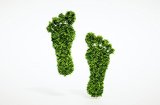Whats an Ecological footprint
 A pint of local beer has a smaller carbon footprint than a mass-produced brew. Photograph: Brian Harris/Rex Features guardian.co.uk
A pint of local beer has a smaller carbon footprint than a mass-produced brew. Photograph: Brian Harris/Rex Features guardian.co.uk
The carbon footprint of a pint of beer:
300g CO2e: locally brewed cask ale at the pub
500g CO2e: local bottled beer from a shop or foreign beer in a pub
900g CO2e: bottled beer from the shop, extensively transported
Beer is unlikely to dominate your carbon footprint but it can make a significant contribution. According to my calculations, a few bottles of imported lager per day might add up to as much as a tonne of CO2e per year – equivalent to around 50, 000 cups of black tea.
The beer at the low end of the scale is based on figures for the Keswick Brewing Company, a microbrewery quite near where I live. Just about everything you can think of was included in the study I did for them. There were the obvious things such as ingredients, packaging, fuel, electricity and transport. I also included such elements as staff travel, the carbon cost of having to replace their equipment every so many years, and office stationery.
For the Keswick Brewing Company, I estimated that ingredients accounted for about one-third of the footprint, fuel and electricity about another one-quarter, and staff travel about one-tenth. The fermentation process itself releases CO2, accounting for about one-twentieth (15g per pint). Most of the company's beer is sold in reusable casks, so the footprint of packaging is kept right down.
Here's a full breakdown of the footprint of a Keswick pint:
Ingredients: 36%
Electricity: 26%
Equipment: 13%
Travel and commuting: 10%
Freight: 7%
Fermentation: 5%
Packaging: 3%
A few miles from the Keswick Brewery is another, larger brewery. Delivery from there to pubs just down the road is via a distribution centre in Wolverhampton, a couple of hundred miles away. This is the usual story for big breweries and their subsidiaries. Even the country of origin is not always obvious from the branding. Although a few hundred road miles are not usually the most significant factor for foods, beer is an exception because it's so heavy. Hence opting for local ale is usually a good idea.
For home consumption, and thinking for a moment only of carbon rather than taste, cans are slightly better than bottles, provided you recycle them. (I can feel the connoisseurs at Keswick cringing as I write.) Heeding this advice is especially important if the beer is travelling a long way because the glass also adds to the weight.
Wherever and whatever you drink, a single pint of a quality beer is almost always better for both you and the planet than spending the same money on several tins of bargain-basement brew.
• This article is drawn from How Bad Are Bananas? The Carbon Footprint of Everything by Mike Berners-Lee


|
Is your lunch causing global warming? Cars and factories are major sources of greenhouse gas emissions that are heating up the planet. But what you ... An article from: New York Times Upfront Book (Scholastic, Inc.) |

|
Wallmonkeys Ecological Footprint Symbol Peel and Stick Wall Decals (24 in W x 16 in H) Home (Wallmonkeys)
|